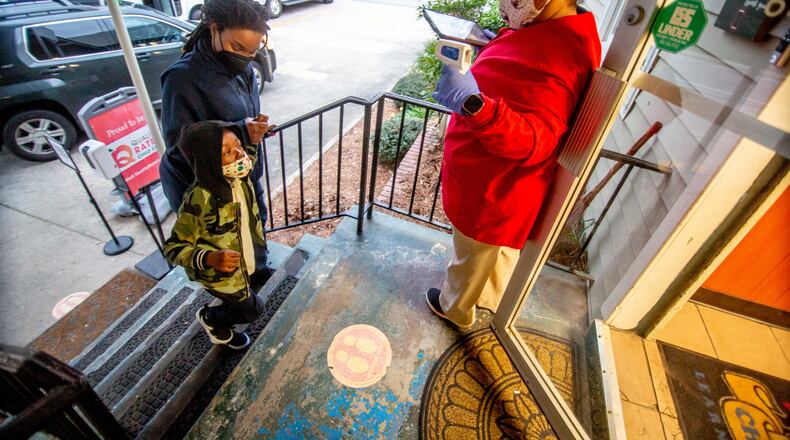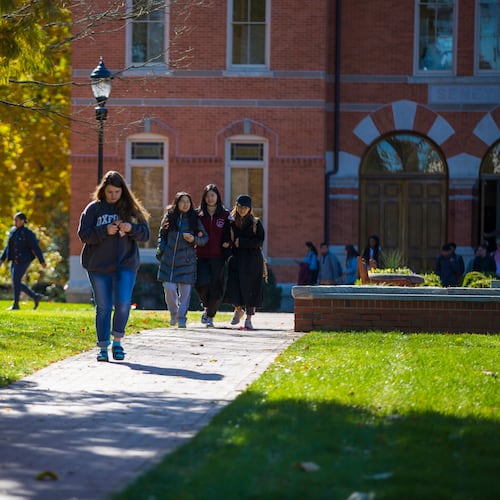When parents of young children get vaccinated and try to return to their workplaces this summer, they will likely encounter a major obstacle: child care.
Despite reports nationally of a child care industry in crisis, Georgia’s centers have endured, with operators crediting the way the state handled the pandemic, quickly passing through federal aid and allowing them to stay open when schools closed. However, COVID-19 has accelerated a staffing shortage that has been years in the making as standards — and educational requirements for teachers — have risen but pay has not.
Unprecedented billions in federal stimulus dollars meant to address the problem will likely help, but only temporarily. And the federal assistance cuts both ways, as unemployment checks tempt potential workers to stay home, state officials and child care operators say.
“These teachers are, on the average, paid between $9 and $10 an hour,” said Amy Jacobs, commissioner of the Georgia Department of Early Care and Learning, which regulates the industry. “And so many of them can make more unemployed, unfortunately.”
Credit: Steve Schaefer
Credit: Steve Schaefer
Last spring, enrollment tumbled as parents withdrew from workplaces and kept their children home. Only 30% of children kept coming, and fewer than a third of child care centers stayed open, either due to low demand, fearful staff or both.
Those numbers have bounced back considerably. Although at least 97% of centers are open, their enrollment is still down from pre-pandemic levels, with at least 1 in 4 fewer children attending.
That means less tuition income, but these businesses, from mom and pop shops in homes to large franchises housing a couple of hundred kids or more, have survived with the help of federal stimulus checks.
The industry also credits Gov. Brian Kemp’s “forward-thinking” approach to child care, said Wande Okunoren-Meadows, who operates a child care center in Forest Park and is vice president of the Georgia Child Care Association.
“I’ve heard from other states that some of those child care providers, they’ve closed and they have not been able to reopen,” she said. But Kemp never ordered centers closed and quickly relaxed caps on group gathering sizes, which by limiting classroom capacity were driving up costs.
Still, Okunoren-Meadows said enrollment is down considerably at her Little Ones Learning Center. It is in Clayton County, one of the few school districts still operating exclusively online.
But Clayton County Public Schools will resume in-person classes in mid-April, and Okunoren-Meadows expects demand to rise when parents and older siblings are no longer at home. However, she is finding it difficult to hire new employees. Before the pandemic, she said, a help-wanted ad might draw 300 applicants per week. Now, she’s lucky if she can attract 20 and find one qualified hire in the mix.
Rich Kernan is noticing the same clashing trends in north Fulton County, where he and his wife own two Kids ‘R’ Kids franchises: They started fielding a lot more calls from interested parents a month or so ago, but they can’t staff up.
Credit: Alyssa Pointer
Credit: Alyssa Pointer
Demand for spots “is on the front end of exploding,” he said, with at least 25 families on their waiting lists. “We get calls nonstop, from either parents looking to return who’ve been out all this time because they’re afraid of COVID or from families we’ve never heard from looking for child care for the first time.”
He said competitors in a 10-mile radius have posted hundreds of help wanted listings online. He is offering $500 signing bonuses to stand out, but it hasn’t helped.
Grants from the prior federal stimulus packages have kept him and his wife, Peggy, afloat.
“Thank God for the money from the feds because we just don’t have the money from the tuition that we normally would,” she said. “The flip side is the federal money that’s raining down in the form of DOL to the individual employees.”
Peggy Kernan was referring to state Department of Labor unemployment checks, which were swollen by the same federal stimulus packages that helped her and her husband’s businesses.
The hiring situation may improve when the unemployment subsidy ends. By then, child care centers should be benefiting from the latest round of stimulus — the $1.9 trillion American Rescue Plan signed by President Joe Biden earlier this month.
Georgia has not received an official estimate of the state’s take of the roughly $25 billion reserved for child care in this round. But Jacobs, the state commissioner, estimates it will be at least $1.5 billion. As in the past, the money can be used for grants to operators and for tuition subsidies for low-income parents. There is just a lot more of it this time.
Jacobs is still distributing tens of millions of dollars from the last stimulus check — $403 million for Georgia child care. That amount, signed by then-President Donald Trump in December, came atop $144 million last spring.
“There have been shocking statistics about the number of child care centers that have closed across the country and there are grave concerns that they will not be able to reopen or … stay open unless we provide this support,” Heather Boushey, a member of the White House Council of Economic Advisers, said in a call with local reporters last week.
But the government stimulus is a temporary solution for a growing problem.
Credit: Jenni Girtman
Credit: Jenni Girtman
“If we increase the payroll to the teachers and then that money runs out from the state, how are we going to pay the teachers five years from now? You have to go up on your tuition,” said Ann Weeks, who operates the Five Forks Academy in Lilburn. Yet for many, the tuition — typically $1,000 or so per month ― is already a stretch.
“So the short-term fix might be in but it won’t be a long-term fix and then we’ll be back in the same situation again,” she said.
This influx of cash may sustain the industry through the pandemic, but the wage and cost problems will linger.
Some will pay whatever they can for a safe place to keep their children.
“Oh my goodness: There’s no words to express how important that is. It’s priceless,” said Lori Pressley, a physical therapist whose 4-year-old attends a child care center in Cleveland. Her other daughter is in elementary school.
“My ability to do my job is because I know both my children are being taken care of,” Pressley said. “That’s not just now. That’s always.”
Federal stimulus for Georgia child care
$144 million: CARES I (last spring)
$403 million: CARES II (winter)
$1.5 billion: American Rescue Plan (current estimate)
Source: Amy Jacobs, commissioner, Georgia Department of Early Care and Learning
Georgia Department of Early Care and Learning budget
$1,011,451,849: agency 2020 budget
$571,499,178: federal revenue (57%)
$377,933,046: state lottery revenue (37%)
$61,223,188: state funding (6%)
78,552: fiscal year 2020 applications processed for Childcare and Parent Services (CAPS) tuition subsidy program
Source: Department of Early Care and Learning Fiscal Year 2020 Annual Report
State early care tuition subsidies
$280 million: typical annual allocation for Childcare and Parent Services (CAPS) tuition subsidy program
50,000: students awarded CAPS subsidy
$5,700: average CAPS subsidy (a little over half typical tuition cost)
51,000: being awarded full rather than partial CAPS subsidy using federal CARES II funding
$600 million: the estimated portion of the American Rescue Plan to be used for expanding CAPS subsidies
Source: Amy Jacobs, commissioner, Georgia Department of Early Care and Learning
Child care providers in Georgia
4,434: February 2020
4,478: February 2021
Source: Georgia Department of Early Care and Learning spokesman
About the Author
Keep Reading
The Latest
Featured





